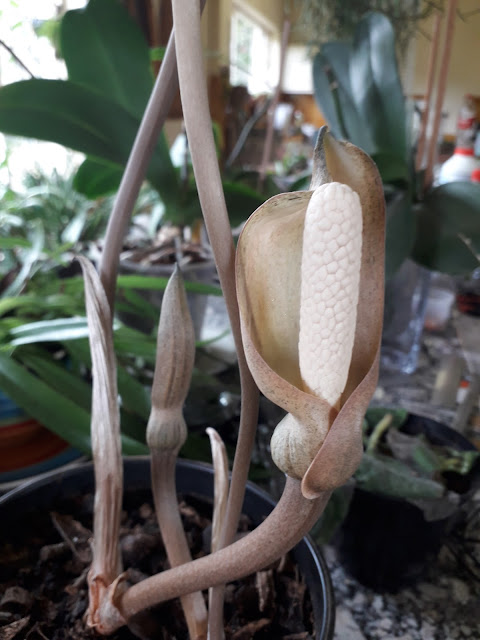Parinari capensis subsp. incohata locally known as umbulwa Maputaland Dwarf Mobola is a very interesting plant being a geoxylic suffrutice plant in the family Chrysobalanaceae. Umbulwa a low growing shrub above the ground are found in large numbers in the grasslands that surround the eMalangeni forest, which plays an important part in the diets of the local people
Simon Ngubane who grew up at eMalangeni told me Parinari capensis subsp. incohata is known by the local people as umbulwa, the fruit is known as ibulwa and the plural is amabulwa.
Inside the fruit which I have eaten is a single large seed or nut that is also eaten. A tasty sauce similar to sauces made from peanuts is made by the people of eMalangeni. The fruit which is like a pear to eat is yellowish when ripe.
Distribution
Parinari capensis subsp. incohata is found in South Africa, Namibia, Botswana, Zimbabwe Mozambique, Tanzania and the Democratic Republic of Congo.
Habitat
Parinari capensis subsp. incohata grow on the edges of vleis, on sandy especially seasonally waterlogged oligotrophic soils and on Kalahari sands where trees are absent. Parinari capensis subsp. incohata can form large patches where they are not grazed by cattle on secondary grassland following destruction of woodland by fire, cultivation etc.
Typical habitat where Parinari capensis subsp. incohata grows note the more visible silver Vernonia natalensis plants.
Description
Parinari capensis subsp. incohata umbulwa is a geoxylic suffrutex having a substantial part of the plant growing under the ground, develops branches leaves flowers and fruit above the ground an adaptation to fire-prone habitats. umbulwa have been considered therefore as forming immortal underground forests of great age.
The woody stems are produced annually from leaf axils at the base of old stems usually grow up to 30cm tall, but very rarely to 1 metre, The stems usually dying back to the base at the end of the growing season, though occasionally growing on into the following year The leaves are elliptical with a white underside.
Umbulwa has small white flowers with a hairy sand-coloured calyx, which are produced from September to October.
The ellipsoidal edible fruit is up to 3cm x 2cm being a yellowish colour when ripe.
Ethnobotanical Uses
The fruit and seed are harvested from the wild for local consumption.
Immature ellipsoidal slightly flattened edible fruit of Parinari capensis subsp. incohata
The fruit is eaten raw or cooked the sweet outer flesh which has a strong, characteristic flavour is eaten although somewhat dry and astringent.
The fruit is often buried in sand for some time before being considered fit to eat
The fruit can also be dried and eaten as a soft cake
The juice of the fruit can be drunk fresh, or concentrated to the consistency of a gruel
The fruit is used for making beer
The crushed kernels are eaten as a relish or are used to make a tasty sauce
The plant is used for anti-malaria purposes.
The Maputaland Wooded Grassland
The Maputaland Wooded Grassland also known as Maputaland, is a vegetation unit (CB2) of the Indian Ocean Coastal Belt Biome and is limited to the Maputaland Centre of Endemism that is found along the coastal plain of northern KwaZulu-Natal and southern Mozambique.
According to the ‘woody grasslands of Maputaland’ and ‘the underground forests of Africa’ are characterized by the many geoxylic (often rhizomatous) suffrutices that occur there. Geoxylic suffrutices, often referred to as ‘underground’ or ‘stunted’ trees, are dwarf woody plants with annual or short-lived woody shoots sprouting from massive or extensive woody, perennial, underground axes . Common examples of geoxylic suffrutices that occur in the woody grasslands of Maputaland are Ancylobotrys petersiana, Diospyros galpinii, Elephantorrhiza elephantine, Eugenia albanensis, Eugenia. capensis, Maytenus nemorosa, Pachystigma venosum, Parinari capensis subsp. incohata and Salacia krausii.
Maputaland Wooded Grassland is also rich in plant species that are endemic to the Maputaland-Pondoland-Albany hotspot, one of the eight most important biodiversity regions in Africa. A biodiversity hotspot is a region of significant biological richness and a high level of endemism which is threatened with destruction.
Associations
I noticed large numbers of the attractive grassland plant Vernonia natalensis belonging to the daisy plant family Asteraceae growing in association with Parinari capensis subsp. incohata a eMalangeni.
Guided excursions
Please join us on one of our many guided excursions conducted in Zulu, English or German into the eMalangeni Forest, Kosi Bay area, Tembe Elephant Park the home of the world largest elephants and other surrounding natural areas. Please visit one of my websites for my contact details.














